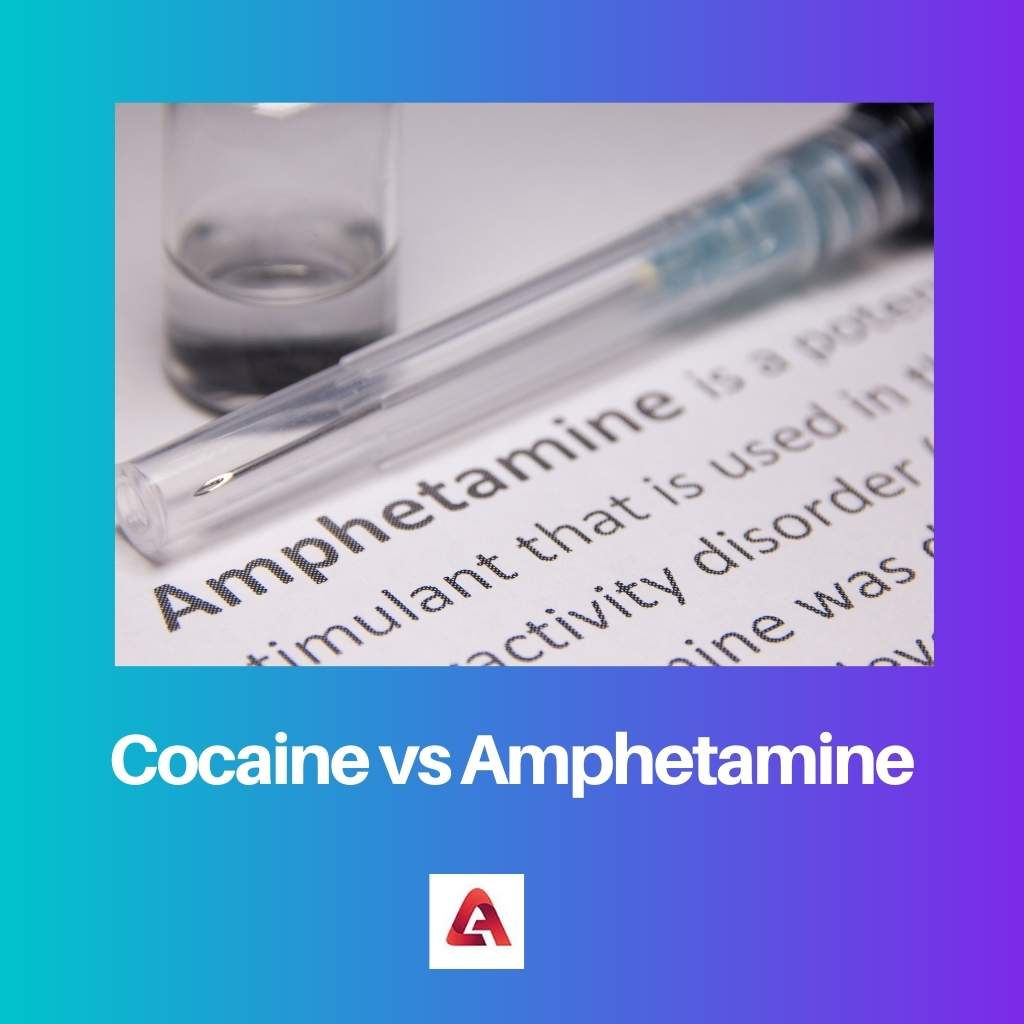Cocaine is a frequently utilised popular drug that is made by naturally extracting it from Coca plants that can be found all over the Andes mountains.
However, Amphetamines are synthetically produced medications that function in a similar way to cocaine. Moreover, when the drug’s effect is measured, it is discovered that Cocaine’s effect lasts for an hour or less and 11-13 hours in the case of Amphetamines.
Key Takeaways
- Cocaine is a naturally occurring stimulant derived from the coca plant, while amphetamines are synthetic.
- Cocaine has a shorter action duration than amphetamines, leading to a more intense but shorter-lived high.
- Cocaine primarily affects dopamine reuptake, while amphetamines influence dopamine, norepinephrine, and serotonin release and reuptake.
Cocaine vs Amphetamine
Cocaine is a medicine and stimulant for the central nervous system, but it is illegal because of its euphoric effects. The medicinal extract is mainly used recreationally. Amphetamine is a stimulant drug that affects the central nervous system and is used to treat narcolepsy and ADHD.

Cocaine can raise levels of dopamine and other neurotransmitters in the body. However, when the drug’s influence is measured, it is discovered that Cocaine’s effect lasts for only an hour or less.
Cocaine is not commonly suggested in medical applications after consumption due to its strong, aggressive adverse effects on the body and brain. It is, however, used as an anaesthetic on occasion.
Amphetamines have the same potential and capability as cocaine, and they aid in the elevation of neurotransmitter levels (such as dopamine) in the body.
However, after monitoring the drug’s effect and influence, it was discovered that it was effective for several hours.
Medical practitioners regularly prescribe them since they are widely employed in the manufacturing of numerous sorts of medicines. They are particularly beneficial in the treatment of ADHD and other physical ailments.
Comparison Table
| Parameters of Comparison | Cocaine | Amphetamine |
|---|---|---|
| Extraction | Coca Plant | Man-made |
| Impact time | 1 hour | 11-13 hours. |
| Use | Anti-depressant, Anesthesia | ADHD, antidepressants. |
| Historical use | Against depression, used as anaesthesia. | To Overcome fatigue at the time of WW2. |
| Half-life | 1 hour | 12-13 hours. |
| Infusion techniques | Intravenously, insufflation, PO, topical. | Insufflation, vaporization, oral, rectal. |
What is Cocaine?
Cocaine can raise the levels of dopamine and other neurotransmitters in the body. Cocaine is not advised in medicinal applications due to its strong, aggressive negative effects on the body and brain after consumption.
It is, nevertheless, occasionally used as an anaesthetic. Cocaine has been used as an oral supplement to treat depression in the past.
However, after learning of the drug’s terrible negative effects, Sigmund Freud lost interest in promoting it, which he had previously recommended.
Cocaine was also used as an anaesthetic once it was isolated from the leaves of the Coca plant. Cocaine’s half-life is estimated to be up to an hour.
Furthermore, when one hour of Cocaine consumption is completed, the body flushes away 50% of the eaten amount from the bloodstream directly.
Cocaine can be infused into the body in a variety of ways, including intravenously, insufflation, and PO. Its main mode of taking is, however, topical.

What is Amphetamine?
Amphetamines have the same potential and capability as cocaine, and they aid in increasing the amounts of neurotransmitters (such as dopamine) in the body.
When the drug’s effect and impact were measured, the drug’s impact was shown to be effective for several hours.
Amphetamines have very few negative side effects when consumed. They are regularly prescribed by medical practitioners since they are widely employed in the manufacturing of numerous sorts of medicines.
They are particularly beneficial in the treatment of ADHD and other bodily diseases.
Historically, the usage of amphetamines was widespread and unrivalled during World Battle II, when it was thoughtfully provided to soldiers to assist them in overcoming tiredness caused by war.
The Amphetamines’ half-life is believed to be between twelve and thirteen hours. It will take the body 12 to 13 hours to flush out half of the amount taken directly from the bloodstream.
Amphetamine can be ingested in a variety of ways. Insufflation, vaporisation, oral, rectal, intravenous, and even below the tongue are all options (sub-lingual).

Main Differences Between Cocaine and Amphetamine
- Cocaine is a type of widely used popular drug which is prepared by extracting it naturally from the Coca plants, which are found extensively around the Andes mountains. On the other hand, Amphetamines are drugs that work similarly to Cocaine and are prepared synthetically in the laboratory.
- Cocaine has the potential to increase the levels of certain neurotransmitters in the body, like dopamine. However, when the impact of the drug is monitored, it was seen that the impact of Cocaine can be seen for an hour or less. On the other hand, Amphetamines possess the same potential and capability as Cocaine and help in raising the neurotransmitter (like dopamine) levels high in the body. However, when the effect and impact of the drug were monitored, its impact came out to be effective for several hours.
- After consuming Cocaine, due to its highly attacking side effects on the body and brain, Cocaine is not recommended frequently in medical applications. However, sometimes it is used as anaesthesia. On the other hand, Amphetamines have negligible side effects of consuming it. As they are used extensively in the preparation of various types of medicines, they are prescribed by medical practitioners frequently. Specially they help in aiding ADHD and different disorders in the body.
- Historically noting, Cocaine was used as an oral supplement to fight against depression. However, after understanding its severe side effects, Sigmund Freud no longer took an interest in promoting the drug, which he used to recommend before. Moreover, after isolating from the leaves of the Coca plant, Cocaine was practised as Anesthesia. On the other hand, historically, the use of Amphetamines was popular and unparalleled at the time of World War II, when it was mindfully given to Soldiers to help them overcome fatigue caused by war.
- The half-life of Cocaine is estimated at up to an hour only. Moreover, when one hour is spent consuming Cocaine, the body flushes out fifty per cent of the consumed amount from the bloodstream directly. On the other hand, the half-life of the Amphetamines is estimated to last up to twelve to thirteen hours. For the body, it will take around 12 hours to 13 hours to flush out half of the amount consumed from the bloodstream directly.
- The infusion of Cocaine into the body can be done in various ways, including intravenously, insufflation and PO as well. However, its main method of taking is topical. On the other hand, Amphetamine can be consumed in any way of administration. They can be taken via insufflation, vaporization, oral, rectal, intravenous and even below the tongue as well (sub-lingual).


Yes, the details on the half-life of cocaine and how the body flushes out the consumed amount are quite concerning.
Absolutely, the severe side effects of cocaine and its potential for abuse cannot be overlooked, especially in the case of medical applications.
The information on the different methods of ingesting amphetamines, including vaporization and oral administration, was very informative.
The information on the negative side effects of cocaine on the body and brain was an eye-opener. It’s important to understand the risks involved.
This article provided a thorough comparison of cocaine and amphetamines, highlighting their differing impacts and uses. Well-written and informative.
It’s intriguing how cocaine was once utilized as an oral supplement to treat depression, despite its severe negative effects.
I was surprised to learn about the historical use of amphetamines during World War II and its provision to soldiers to overcome fatigue.
This informative article helped me understand the key differences between cocaine and amphetamine and its historical uses. Very interesting.
Yes, the article clearly explained the various ways in which cocaine can be infused into the body, which was quite insightful.
The details on the different methods of ingesting cocaine and amphetamines were quite informative and provided a comprehensive understanding.
The historical context provided in the article about the uses of cocaine and amphetamines was quite fascinating and added depth to the comparison.
Yes, it’s surprising how amphetamines have very few negative side effects and their potential to aid in the elevation of neurotransmitter levels in the body.
I found the historical details about the use of amphetamines during World War II to be quite captivating and informative.
The comparison table provided a clear overview of the main differences between cocaine and amphetamines, making it easy to understand.
I was surprised to learn about the historical use of cocaine as anaesthesia and its effects lasting for a very short duration.
I find it amazing how amphetamines can be used to treat ADHD and other physical ailments, making them beneficial for medical purposes.
The section on the historical use of cocaine and its side effects was fascinating, especially the information on Sigmund Freud’s loss of interest in promoting it.